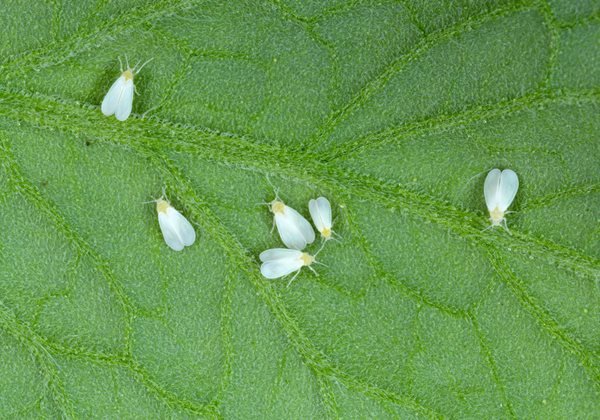A whitefly infestation can be one of the most annoying problems in the plant world. These little white, fly-like insects love houseplants, vegetables, annuals and many other things, and they can be difficult to eliminate.
There are many varieties of these pests and greenhouse whiteflies are the most common here. They are small but easy to spot since you’ll most likely first notice them as they fly around or cluster around your plants. They are often active during the day. If you notice something flying, simply start turning over leaves as they most often congregate and lay eggs on the underside of leaves. Tomatoes, anything in the citrus family, and anything in the cabbage family, and lantana are particular favorites. They seem to favor houseplants with smooth, soft leaves.
Although many people simply find them annoying, it’s important that you identify and eliminate them because they have the ability to kill your plants. Whiteflies do their damage by using piercing mouthparts to suck the juice out of your plants while they feed, thus weakening the plant.
A residual problem is that they excrete a sticky substance called honeydew which drops below and sooty mold can form from these droppings which, in turn, can cause other problems for your plants.
If you have a heavy infestation, plants can quickly become weak and leaves will wilt, turn yellow, be stunted, or shrivel and drop off.
It’s important to get whiteflies under control quickly and the way you do this is by interrupting their life cycle. The mistake most people make is that they think one treatment is adequate and it usually works fine in killing the adults, but they forget about the eggs that have been laid that usually hatch anywhere from a week to a month afterwards. This is why a bad infestation can be so difficult to clean up.
Although some people like to remove them simply by blasting their plants with water or insecticial soaps, these often don’t work well, although they will have some efficacy in scattering them to some extent. I’d recommend doing this outdoors if it all possible. However, none of these methods effectively interrupt the lifecycle which is what will eventually control your infestation.
Neem oil is a good control to try, especially if you are an organic gardener. This insecticial oil works by smothering adults. You should make a second application once the eggs begin to hatch as well in order to really clean up your infestation.
Eight is a newer version of the gardeners old friend Sevin. It’s a permethrin and also works well. It’s not organic so be sure to read and follow label directions to be sure it’s suitable for the plants you are treating. You’ll need two applications of this as well.
Since whiteflies will not survive winters in this area, you’ll very often spot them on houseplants indoors during the winter months. For houseplants, we like Bonide’s Systemic Granules. These are small granules that you sprinkle onto the top of the soil. When you water your plant, the chemical is released and goes down into the soil. The plant then takes it up through it’s root system, hence the name systemic. As the whiteflies feed on the plant, they ingest the poison and are killed. Since the chemical remains in the capillary system of the plant, there is no need for a second application as the eggs that hatch will feed on it and be killed as well. Do not use systemic granules on anything edible however.
A long time ago, I picked up one of my houseplants one day and ended up with whiteflies up my nose and I’ve been at war with any I spot ever since!

